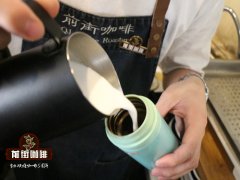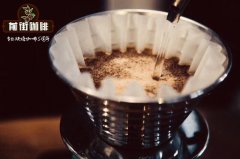The four knowledge points of cappuccino how to make cappuccino the origin and classification of cappuccino name

Professional coffee knowledge exchange more coffee bean information please follow the coffee workshop (Wechat official account cafe_style)
Coffee is a favorite drink in people's daily life, and many people start their work and study with a cup of coffee. There are many kinds of coffee, among which cappuccino coffee is very popular. Today, I would like to introduce to you the four major knowledge points of Puccino.
The origin of the name
The monks of the St. Franciscan Church (Capuchin), founded after 1525, all wore brown robes and pointed hats. When the St. Franciscan Church spread to Italy, the locals thought the monks' clothes were very special, so they gave them the name Cappuccino. The Italian word refers to the loose robes and small pointed hats worn by monks, derived from the Italian word "headscarf" or Cappuccino. However, people found that when espresso, milk and milk foam were mixed, the color was like the dark brown robe worn by monks, so they came up with a drink with milk and coffee and pointed milk foam, which was named Cappuccino. The original word makers who believed Cappuccino never dreamed that the monks' robes would eventually become a coffee drink name:-P
Caffeine content
Average caffeine content: small cup (240cc): 75 mg medium cup (360cc): 75 mg large cup (480cc): 150mg usually a cup of espresso is 10 ml, caffeine ratio: 75 mg. In addition, you can also choose low caffeine (the removal of 98% or more is considered true low caffeine). The average low caffeine content is: small cup: 3 mg, medium cup: 3 mg, large cup: 6 mg.
classification
Cappuccinos are divided into dry and wet ones. The so-called dry cappuccino (Dry Cappuccino) refers to the conditioning method with more milk bubbles and less milk. it tastes stronger than milk and is suitable for people with heavy taste. As for wet cappuccino (Wet Cappuccino), it refers to the practice of fewer milk bubbles and more milk. The smell of milk overshadows the thick smell of coffee, which is suitable for those with light taste. The flavor of the wet cappuccino is similar to that of the popular latte. Generally speaking, the taste of cappuccino is heavier than latte. If you have a heavy taste, you might as well order cappuccino or dry cappuccino. If you are not used to the heavy smell of coffee, you can order latte or wet cappuccino.
The practice of cappuccino coffee
[raw material] Italian coffee beans (usually deep-roasted mixed coffee beans) fresh milk, about 150cc
[practice] extract a standard espresso (espresso) 60cc into a cappuccino cup (standard cappuccino is 180cc), whisk and heat fresh milk refrigerated at low temperature to 60 ℃ (±5 ℃), fully blend foam and milk to a relatively homogeneous state, and pour beat foam and milk into espresso. Usually excluding espresso, the volume ratio of milk to foam is about 1:1.
Okay, Cappuccino gives people the impression of three parts.
The first smell is the mellow aroma of espresso (Espresso) and hot milk
Second, when you drink it, you can feel the sweetness and softness of a large number of milk bubbles, and then you can immediately taste the bitterness and richness of coffee beans and the warmth that slips into the belly.
Third, when the taste stays in your mouth after drinking, you will feel mellow and meaningful again.
Different kinds of coffee can have many different unique tastes. The first sip of good coffee always makes people feel sour and sweet and mellow in the aftertaste, while a lot of cappuccino foam is like the life of young people. The bursting of the bubble and that little bitterness are like a conflict between dream and reality. Finally, after tasting the joys and sorrows of life, the sweetness of life is intoxicating. This is like a teenager in adolescence. After enjoying a childish and wonderful time, they have to face the impact of stepping into the adult world and really taste the original taste of life-in addition to sweetness and bitterness.
Important Notice :
前街咖啡 FrontStreet Coffee has moved to new addredd:
FrontStreet Coffee Address: 315,Donghua East Road,GuangZhou
Tel:020 38364473
- Prev

Fancy Coffee making training: the difference between a cappuccino Cappuccino and a latte
Professional coffee knowledge exchange more coffee bean information please follow the coffee workshop (Wechat official account cafe_style) * cappuccino coffee practice Cappuccino materials: full-fat fresh milk, cinnamon powder. Practice: A. Boil a portion of espresso (semantic concentrate). B . Add hot fresh milk and fresh milk foam, the ratio is 1:1:1, the finished weight is 140cc to
- Next

What's the taste of coffee? does coffee taste good? there are several flavors of coffee.
Professional coffee knowledge exchange more information about coffee beans Please follow the coffee workshop (Wechat official account cafe_style) Coffee is bitter. Many people think that the bitterness in coffee comes from caffeine. In fact, the roasted coffee beans will produce a continuous reaction. The chlorogenic acid in the coffee beans will be converted to chlorogenic acid lactone, which will continue to deepen the baking degree, and then will be decomposed into phenyl dihydrogenated indene.
Related
- Beginners will see the "Coffee pull flower" guide!
- What is the difference between ice blog purified milk and ordinary milk coffee?
- Why is the Philippines the largest producer of crops in Liberia?
- For coffee extraction, should the fine powder be retained?
- How does extracted espresso fill pressed powder? How much strength does it take to press the powder?
- How to make jasmine cold extract coffee? Is the jasmine + latte good?
- Will this little toy really make the coffee taste better? How does Lily Drip affect coffee extraction?
- Will the action of slapping the filter cup also affect coffee extraction?
- What's the difference between powder-to-water ratio and powder-to-liquid ratio?
- What is the Ethiopian local species? What does it have to do with Heirloom native species?

